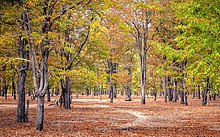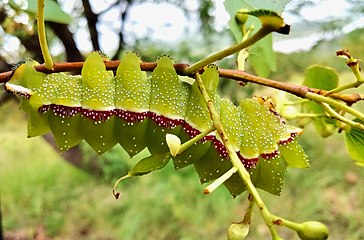| Mopane | |
|---|---|

| |

| |
| Multi-stemmed shrub and tall woodland in Namibia and Malawi respectively | |
| Scientific classification | |
| Kingdom: | Plantae |
| Clade: | Tracheophytes |
| Clade: | Angiosperms |
| Clade: | Eudicots |
| Clade: | Rosids |
| Order: | Fabales |
| Family: | Fabaceae |
| Subfamily: | Detarioideae |
| Tribe: | Detarieae |
| Genus: | Colophospermum J.Léonard (1949), nom. cons. |
| Species: | C. mopane |
| Binomial name | |
| Colophospermum mopane (J.Kirk ex Benth.) J.Léonard (1949) | |

| |
| Synonyms | |
| |
Colophospermum mopane, commonly called mopane, mopani, balsam tree, butterfly tree, or turpentine tree, is a tree in the legume family (Fabaceae), that grows in hot, dry, low-lying areas, 200 to 1,150 metres (660 to 3,770 ft) in elevation, in the far northern parts of Southern Africa. The tree only occurs in Africa and is the only species in genus Colophospermum. Its distinctive butterfly-shaped (bifoliate) leaf and thin seed pod make it easy to identify. In terms of human use it is, together with camel thorn and leadwood, one of the three regionally important firewood trees.
Range and habitat

It is native to Southern Africa, including Southern Angola, Zambia, Southern Malawi, Namibia, Botswana, Zimbabwe, Mozambique and northern South Africa. It grows in alkaline (high lime content) soils which are shallow and not well drained. It also grows in alluvial soils (soil deposited by rivers). Where it occurs, it is often the dominant tree species, frequently forming homogeneous stands. In Northern South Africa and larger adjacent areas of Botswana and Zimbabwe, with the trees' height varying between 4 and 18 m (13 and 59 ft), they are often called "mopane scrub" (shrub). However, they can also sometimes grow taller in these areas, forming woodland. Further north the trees are taller and form tall woodlands referred to as cathedral mopane. This tree does not grow well outside hot, frost-free areas with summer rainfall.
Mopane ecoregions
There are two ecoregions where mopane is the predominant vegetation. The Angolan mopane woodlands are in southwestern Angola and northern Namibia, and the Zambezian and mopane woodlands extend over the lowlands of the Zambezi River and its tributaries in Botswana, Eswatini, Namibia, Zambia, Zimbabwe, Mozambique, Malawi, and South Africa.
Uses

 A large multi-stemmed tree with sociable weaver nests, and a shrub browsed on by goats, both in Namibia
A large multi-stemmed tree with sociable weaver nests, and a shrub browsed on by goats, both in Namibia
Mopane wood is one of southern Africa's heaviest, with a density of 1.075 g/cm when completely dry, and is difficult to work because of its hardness. However, this also makes it termite resistant. For this reason it has long been used for building houses and fences, as railway sleepers and as pit props. The termite-resistance and rich, reddish colouring also make it popular for flooring. Outside Africa, mopane is gaining popularity as a heavy, decorative wood, its uses including aquarium ornaments, bases for lamps or sculptures, and garden accents.
It is also increasingly being used in the construction of musical instruments, particularly woodwind. Suitable quality African blackwood (Dalbergia melanoxylon), traditionally used for clarinets, is becoming harder to find. Mopane is fairly oily, seasons very well with few splits or shakes, and produces instruments of a warm, rich tone. Clarinets made of mopane are offered by the manufacturers Seggelke Klarinetten, F. Arthur Uebel and Buffet Crampon.
Mopane twigs have been traditionally used as tooth brushes, the bark to make twine and for tanning leather, and the leaves for healing wounds. The wood is also used to make charcoal and for braai wood.
The tree is a major food source for the mopane worm, the caterpillar of the moth Gonimbrasia belina. The caterpillars are rich in protein and are eaten by people. The mopane worm is rich in crude fats and contains vitamins and minerals, such as iron, calcium and phosphorus. The tree also acts as a foodplant for the wild silk moth, Gonometa rufobrunnea. Cocoons of the moth are harvested as wild silk, to make cloth.
The Mopane worm creates employment and serves as a source of income for the majority of rural women. Harvesters sell it in villages, towns or to the trader
The mopane tree also serves as a host plant for the mopane psyllid Retroacizzia mopani.
Etymology
Colophospermum is Latinised Greek for "oily seed", in reference to the resinous seed (i.e. spermum) which has a turpentine smell. Colophon was the birthplace of Homer in Ionia, and was famous for its rosin, a substance obtained from turpentine or the gummy exudate of some trees. The species name mopane is taken from the local name for the tree.
Gallery
-
 Inflorescences produced during mid-summer
Inflorescences produced during mid-summer
-
 The wind-pollinated flower
The wind-pollinated flower
-
 Dry foliage, seed pods and two seeds (bottom right) - MHNT
Dry foliage, seed pods and two seeds (bottom right) - MHNT
-
 The fruit are pods containing one seed each
The fruit are pods containing one seed each
-
 Mopane worms, locally a staple food, consuming the foliage
Mopane worms, locally a staple food, consuming the foliage
-
 The likewise edible chipumi caterpillar of the speckled emperor moth, defoliating a sprig
The likewise edible chipumi caterpillar of the speckled emperor moth, defoliating a sprig
-
Winter foliage and dry seed pods in Namibia
See also
References
 Media related to Colophospermum mopane at Wikimedia Commons
Media related to Colophospermum mopane at Wikimedia Commons
- Colophospermum mopane (J.Kirk ex Benth.) J.Léonard. Plants of the World Online. Retrieved 16 August 2023.
- ^ "Colophospermum mopane". Germplasm Resources Information Network. Agricultural Research Service, United States Department of Agriculture. Retrieved 15 December 2017.
- "Mopane | The Wood Database – Lumber Identification (Hardwood)". Retrieved 25 June 2020.
- van Wyk, Piet (1984). Field Guide to the Trees of the Kruger National Park. Cape Town: Struik. p. 83. ISBN 0-86977-221-X.
- The Wood Database Archived 15 July 2016 at the Wayback Machine Mopane. Retrieved 24 June 2013.
- Prosono International Archived 22 November 2009 at the Wayback Machine Woods for woodwinds. Retrieved 23 April 2010.
- Potgieter, Martin (2015). Edible insects in Africa: An introduction to finding, using and eating insects. Wageningen: Agromisa Foundation and CT. p. 34. ISBN 978-90-8573-146-7.
- Potgieter, Martin (2015). Edible insects in Africa An introduction to finding, using and eating insects. Wageningen: Agromisa Foundation and CTA. p. 34. ISBN 978-90-8573-146-7.
- Oppong, C.K., Addo-Bediako, A., Potgieter, M.J. & Wessels, D.C.J. 2009. Distribution of the eggs of the mopane psyllid Retroacizzia mopani (Hemiptera: Psyllidae) on the mopane tree. African Invertebrates 50 (1): 185–190.
- Oppong, C.K., Addo-Bediako, A., Potgieter, M.J. & Wessels, D.C.J. 2010. Nymphal behaviour and lerp construction in the mopane psyllid Retroacizzia mopani (Hemiptera: Psyllidae). African Invertebrates 51 (1): 201–205."Archived copy". Archived from the original on 24 June 2010. Retrieved 3 June 2010.
{{cite web}}: CS1 maint: archived copy as title (link) - A reference to the species' resinous seed: 'Origins and Meanings of Names of South African Plant Genera' – W.P.U. Jackson (1990)
- Esterhuyse, N., Von Breitenbach, J. & Söhnge, H. 2001. Remarkable trees of South Africa. Briza Publications, Pretoria.
- Ferwerda, J.G. (2005) Charting the quality of forage: measuring and mapping the variation of chemical components in foliage with hyperspectral remote sensing. Wageningen, Wageningen University, 2005. ITC Dissertation 126, 166 p. ISBN 90-8504-209-7.
| Taxon identifiers | |
|---|---|
| Colophospermum mopane |
|
| Colophospermum |
|
| Copaifera mopane | |